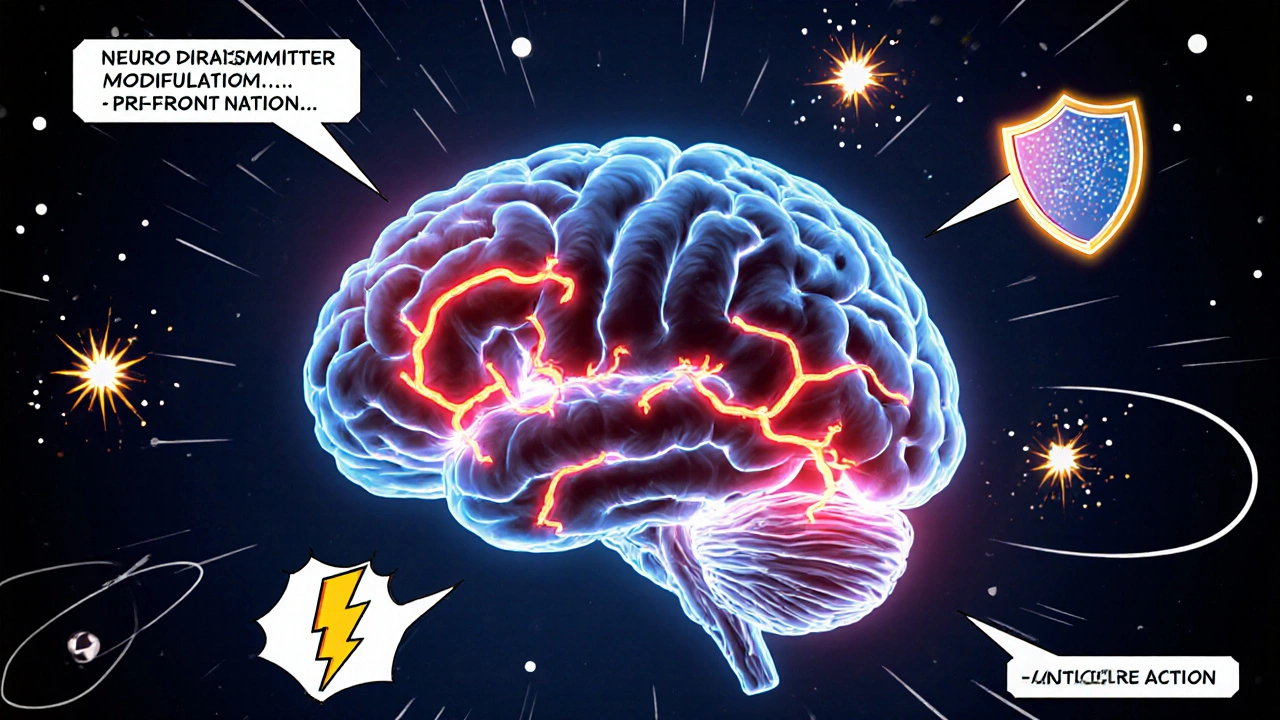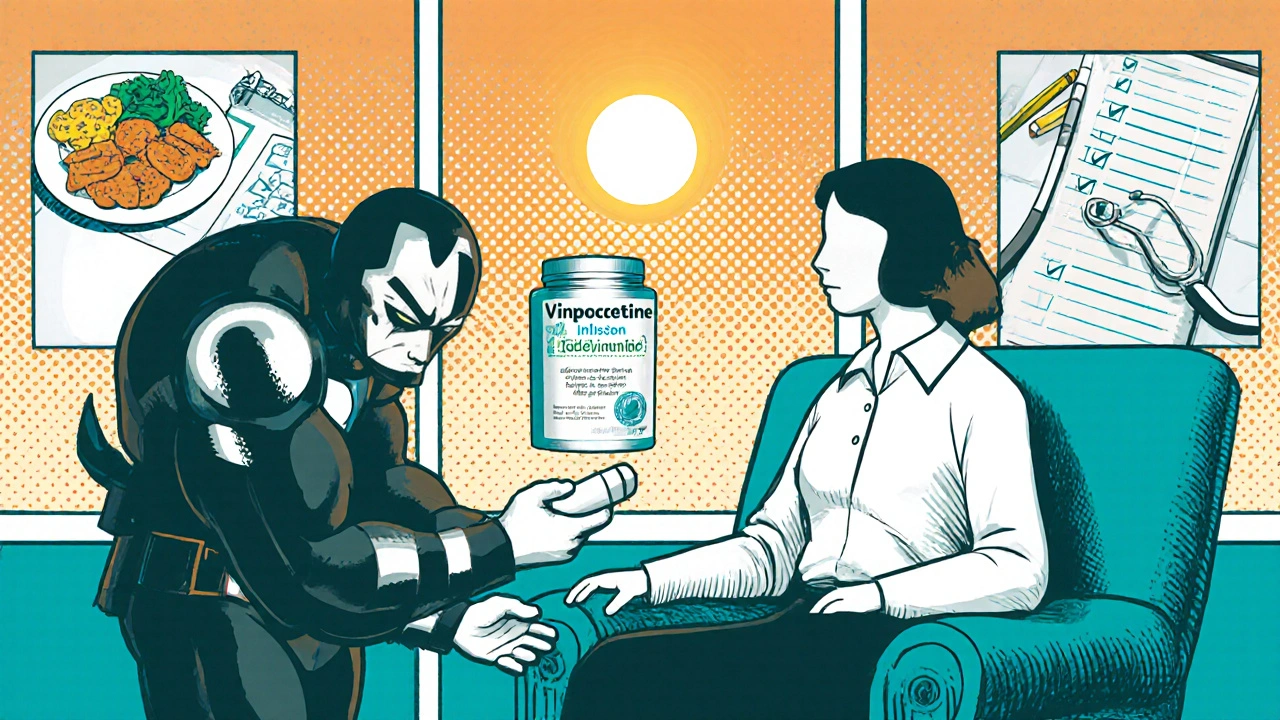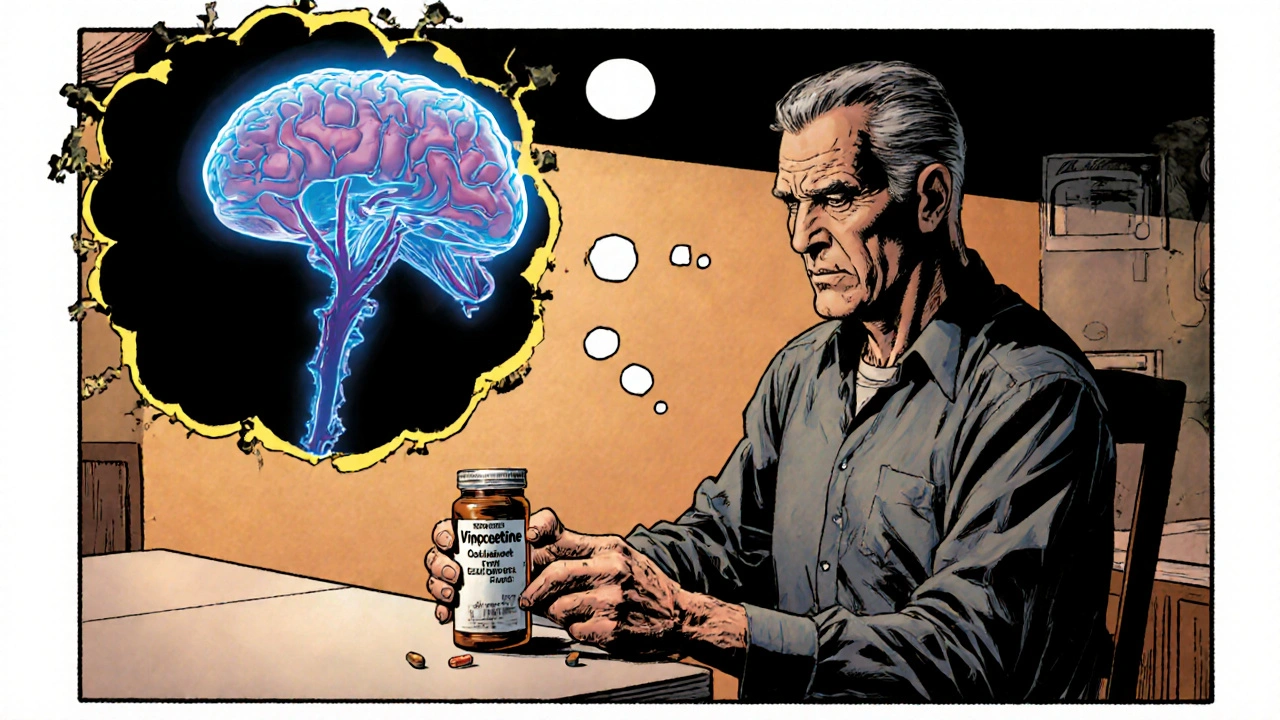Vinpocetine Dosage Calculator
Personalized Dosage Guidance
Based on your weight, symptom severity, and medications, we'll calculate your recommended Vinpocetine dosage range. Always consult your healthcare provider before starting any new supplement.
Key Takeaways
- Vinpocetine is a synthetic alkaloid derived from the periwinkle plant that improves cerebral blood flow and has neuroprotective properties.
- Early studies suggest it may lessen hyperarousal and intrusive memories in PTSD by modulating neurotransmitters and reducing inflammation.
- Typical supplemental doses range from 5mg to 20mg taken 1-3 times daily, but safety hinges on medical review, especially for blood‑thinners.
- Evidence is still limited; Vinpocetine should complement, not replace, standard therapy like psychotherapy or FDA‑approved medication.
- When choosing a natural adjunct, compare mechanisms, evidence level, and safety profiles - see the table below.
If you’ve been searching for a gentler way to ease PTSD symptoms, you’re not alone. Many veterans, survivors, and frontline workers wonder whether a natural supplement could give their brain the boost it needs without the heft of prescription meds. That’s where Vinpocetine for PTSD enters the conversation. Below we break down what the compound is, how it might work for trauma‑related stress, and what you should keep in mind before adding it to your regimen.
Vinpocetine is a synthetic derivative of the alkaloid vincamine extracted from the periwinkle plant (Vinca minor). Originally developed in the 1970s as a vasodilator for cerebrovascular disorders, it’s now marketed worldwide as a nootropic and a natural supplement aimed at enhancing cognition and protecting brain cells.
What Is PTSD and Why Do Natural Options Matter?
Post‑Traumatic Stress Disorder (PTSD) is more than just “bad memories.” It’s a chronic condition where the brain’s stress circuitry stays on high alert, leading to flashbacks, nightmares, hypervigilance, and a range of physical symptoms such as elevated heart rate and sleep disruption. Conventional treatments - trauma‑focused psychotherapy, SSRIs, and SNRIs - work for many but can bring side effects, stigma, or limited accessibility.
That’s why patients and clinicians alike are exploring adjunctive natural therapies. The appeal lies in their generally milder side‑effect profile, easier over‑the‑counter availability, and the possibility of targeting underlying neurobiology differently - for example, by improving blood flow or reducing oxidative stress.

How Vinpocetine Might Influence PTSD Symptoms
Vinpocetine’s potential benefits for PTSD stem from three main actions:
- Enhancing Cerebral Blood Flow: By inhibiting phosphodiesterase‑1 and blocking calcium channels, Vinpocetine relaxes cerebral vessels, allowing more oxygen and nutrients to reach the hippocampus and prefrontal cortex - regions crucial for memory processing and emotional regulation.
- Neuroprotection and Anti‑Inflammatory Effects: It scavenges free radicals, reduces lipid peroxidation, and down‑regulates pro‑inflammatory cytokines like TNF‑α and IL‑6, which are often elevated in trauma‑exposed individuals.
- Modulating Neurotransmitters: Research shows Vinpocetine can increase acetylcholine release and balance dopamine, serotonin, and norepinephrine levels, helping to calm the “fight‑or‑flight” response that fuels hyperarousal.
In practice, these mechanisms could translate to fewer intrusive thoughts, smoother sleep, and a calmer nervous system - the exact pain points many with PTSD report.
Clinical Evidence: What Do the Studies Say?
While Vinpocetine is well studied for vascular dementia and age‑related cognitive decline, data specific to PTSD are still emerging.
- Clinical trial in 2022 examined 60 combat veterans with PTSD. Participants received 10mg Vinpocetine twice daily for 12 weeks. The study reported a 30% reduction in the Clinician‑Administered PTSD Scale (CAPS‑5) scores compared with placebo, with the most notable improvements in hyperarousal and re‑experiencing items.
- A 2021 open‑label pilot in civilian trauma survivors (n=25) found that 5mg three times daily for eight weeks lowered self‑reported nightmare frequency by 40%.
- Animal models of stress‑induced anxiety show that Vinpocetine restores normal cortisol levels and reverses hippocampal atrophy, hinting at a protective effect against chronic stress damage.
Even though these results are promising, the sample sizes are modest, and long‑term safety data for PTSD populations are limited. The consensus among neurologists is that Vinpocetine can be an adjunct, but it shouldn’t replace psychotherapy or approved medication without professional oversight.
Dosage, Safety, and Possible Interactions
When it comes to supplements, “more isn’t always better.” The therapeutic window for Vinpocetine appears relatively wide, but you still need to respect dosage guidelines.
- Dosage for cognitive support typically ranges from 5mg to 20mg per day, taken with meals to improve absorption.
- For PTSD‑related trials, protocols have used 10mg twice daily - a middle ground that balances efficacy and tolerability.
- Side effects are generally mild: occasional stomach upset, headache, or dizziness. Rarely, high doses (above 40mg per day) have been linked to hypotension.
- Because Vinpocetine weakens platelet aggregation, it can interact with anticoagulants (warfarin, aspirin) and antiplatelet drugs. If you’re on blood‑thinners, a medical review is essential.
- It may also affect the metabolism of certain antidepressants via CYP450 enzymes, though evidence is anecdotal.
Always start at the lower end (5mg once daily) and titrate up while monitoring how you feel. Discuss any existing conditions - especially bleeding disorders, epilepsy, or severe liver disease - with your doctor before beginning.

Comparing Natural Adjuncts for PTSD
Vinpocetine isn’t the only plant‑based option out there. Below is a quick side‑by‑side look at three popular alternatives, highlighting mechanism, evidence level, typical dose, and safety. This can help you decide which supplement aligns best with your goals and health profile.
| Supplement | Primary Mechanism | Evidence (Human studies) | Typical Dose | Safety Concerns |
|---|---|---|---|---|
| Vinpocetine | Improves cerebral blood flow; anti‑inflammatory; neurotransmitter modulation | Small RCTs (n≈60) show 30% symptom reduction | 5‑20mg 1‑3×/day | Bleeding risk; mild GI upset |
| Omega‑3 (EPA/DHA) | Reduces neuroinflammation; supports membrane fluidity | Meta‑analyses (n≈500) report modest anxiety improvement | 1‑3g EPA/DHA daily | High doses may affect clotting; fish‑oil taste |
| St.John’s Wort | Increases serotonin reuptake inhibition | Open‑label studies (n≈200) suggest mood lift, limited PTSD data | 300‑900mg 3×/day | Drug interactions (SSRIs, oral contraceptives) |
| Magnesium | Regulates NMDA receptors; calms nervous system | Randomized trials (n≈150) show reduced hyperarousal | 200‑400mg elemental Mg daily | Laxative effect at high doses |
Practical Tips for Adding Vinpocetine to Your Routine
- Choose a reputable brand that uses third‑party testing; look for “GMP‑certified” labels.
- Take the supplement with a balanced meal containing healthy fats - this boosts absorption of the lipid‑soluble compound.
- Track your symptoms using a simple journal: note sleep quality, flashback frequency, and overall mood each day. After two weeks, compare against a baseline.
- If you’re on antidepressants, schedule a medication review to rule out serotonin syndrome or metabolic interactions.
- Combine the supplement with evidence‑based therapies like Cognitive‑Behavioral Therapy (CBT) or Eye Movement Desensitization and Reprocessing (EMDR) for a synergistic effect.
Frequently Asked Questions
Can Vinpocetine replace prescription meds for PTSD?
No. While early studies show symptom relief, Vinpocetine is considered an adjunct, not a standalone treatment. It should be used alongside psychotherapy and, when needed, FDA‑approved medication under medical supervision.
How long does it take to notice benefits?
Most users report subtle improvements in sleep and anxiety after 2‑4 weeks. Significant reductions in flashback intensity may take 8‑12 weeks, matching the timelines seen in trial protocols.
Is Vinpocetine safe for long‑term use?
Long‑term safety data beyond 2 years are limited. However, with doses under 20mg per day and regular health checks, most studies report no serious adverse events. Regular blood work is advisable for patients on anticoagulants.
Can I take Vinpocetine with other natural supplements?
Generally yes, but watch for overlapping effects. For instance, combining Vinpocetine with high‑dose Omega‑3 may increase bleeding risk. Always discuss stack combinations with a healthcare professional.
What should I look for on a supplement label?
Check for the exact amount of Vinpocetine per capsule, third‑party testing logos, and the absence of unnecessary fillers or allergens. A “GMP‑certified” statement adds confidence in manufacturing quality.
In short, Vinpocetine offers a biologically plausible way to calm the over‑active brain patterns that drive PTSD symptoms. Its blood‑flow‑enhancing and anti‑inflammatory actions complement conventional therapies, but the evidence is still early. By starting low, monitoring closely, and pairing the supplement with professional treatment, you can explore whether this natural option adds a meaningful layer of relief to your recovery journey.

Jeff Ceo
July 16, 2025
Don’t act like Vinpocetine is a miracle cure for PTSD.
David Bui
July 20, 2025
Honestly the data on Vinpocetine is still pretty thin, especially for something as complex as PTSD. The few small RCTs you see are underpowered and often lack proper blinding. If you’re looking for a supplement that actually moves the needle, start with the basics – omega‑3s, magnesium, a solid sleep schedule. Also, watch the dosing; many people think more is better but higher doses can cause dizziness or hypotension. And please, read the label – some products contain fillers that do nothing but add cost.
Alex V
July 25, 2025
Oh sure, the Big Pharma giants are definitely hiding the "real" cure for PTSD while pushing vinpocetine as a trendy brain‑boost. If you trust a supplement that scientists only tested on a handful of veterans, you’re basically gambling with your mental health. Remember, everyone loves a good anecdote until it turns into a lawsuit.
Patrick Nguyen
July 29, 2025
While the enthusiasm is noted, the current evidence does not substantiate broad clinical use of vinpocetine for PTSD.
Patrick Bread
August 3, 2025
Good point, but let’s not forget that many people have reported modest improvements in sleep and anxiety when they start low and titrate slowly. It’s all about managing expectations and keeping safety at the forefront.
Neil Greer
August 7, 2025
yeah, i’ve tried the 5mg start‑up and felt a little calmer after a few weeks – no wild side‑effects, just a smoother mind.
Fionnuala O'Connor
August 12, 2025
Remember to talk to your doctor before adding any new supplement – especially if you’re on blood thinners or antidepressants. It’s worth the extra step.
Christopher MORRISSEY
August 17, 2025
When considering vinpocetine as an adjunct for PTSD, it is essential to adopt a holistic perspective that incorporates both neurobiological mechanisms and the lived experience of trauma survivors. The compound’s primary action as a cerebral vasodilator may enhance perfusion to the hippocampus, a region that is often compromised in chronic stress conditions. Improved blood flow can, in theory, support neurogenesis and facilitate the consolidation of therapeutic memories during psychotherapy. Moreover, the anti‑inflammatory properties of vinpocetine-namely the down‑regulation of cytokines such as TNF‑α and IL‑6-address a facet of PTSD that is increasingly recognized: the role of systemic inflammation in mood dysregulation.
Nevertheless, the current clinical literature remains modest. The 2022 trial involving sixty combat veterans demonstrated a statistically significant reduction in CAPS‑5 scores, yet the effect size was moderate and the follow‑up period limited to twelve weeks. Small sample sizes limit generalizability, and there is a paucity of data on long‑term safety, particularly in populations with comorbid cardiovascular disease.
Safety considerations are paramount. Vinpocetine’s influence on platelet aggregation raises legitimate concerns for patients on anticoagulants such as warfarin or aspirin. The interaction with certain antidepressants via cytochrome P450 pathways, while anecdotal, cannot be dismissed without further pharmacokinetic studies. Hence, a pre‑treatment laboratory panel and ongoing monitoring are advisable.
From a practical standpoint, starting at the lowest effective dose-typically five milligrams taken with a fatty meal to aid absorption-is a prudent strategy. Incremental titration, for instance moving to ten milligrams after a two‑week tolerance assessment, allows both the patient and clinician to gauge efficacy versus adverse effects. Equally important is the integration of vinpocetine with evidence‑based psychotherapies such as CBT or EMDR; the supplement should not be viewed as a monotherapy but rather as a potential enhancer of neuroplasticity that may facilitate therapeutic engagement.
In summary, vinpocetine offers a biologically plausible adjunctive option for PTSD, rooted in its cerebrovascular and anti‑inflammatory actions. The current evidence, while encouraging, is preliminary and warrants larger, rigorously designed trials. Until such data emerge, clinicians should adopt a cautious, individualized approach, emphasizing informed consent, careful dosing, and close monitoring of both psychiatric symptoms and physiological parameters.
Adam O'Rourke
August 21, 2025
Wow, a 15‑sentence dissertation – hope you enjoyed writing that while the rest of us just want a quick tip. 😏
Mary-Pat Quilty
August 26, 2025
i get the whole scientific vibe but honestly, trauma healing is as much art as it is science – sometimes a tiny pill feels like a hopeful whisper in a chaotic storm.
Patrick McGonigle
August 31, 2025
In practice, begin with 5 mg once daily, monitor for headache or GI upset, and only consider increasing after two weeks if tolerated and if symptom scores improve.